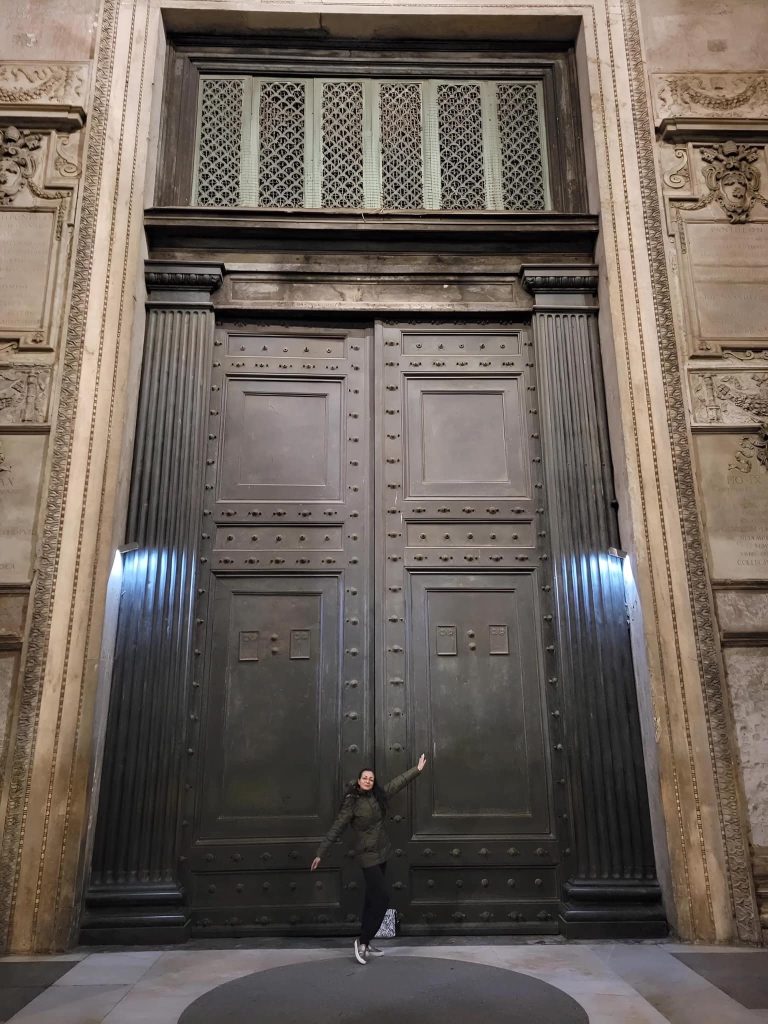Standing quietly yet powerfully at the entrance of Rome’s iconic Pantheon are two ancient bronze doors—widely regarded as the oldest functioning doors in the world. These monumental structures have stood the test of time for nearly 2,000 years, welcoming generation after generation of visitors into one of the most celebrated architectural masterpieces of antiquity. Their existence is more than ornamental or functional; they represent the incredible ingenuity, advanced craftsmanship, and enduring spirit of Roman engineering. For Americans and people across the world, they offer a rare opportunity to physically engage with a living piece of history that has transcended empires, religions, and centuries.

Installed around 115 AD during the reign of Emperor Hadrian, these doors are marvels not just because of their age, but because of their immense size and functionality. Each bronze door soars to a height of 25 feet and stretches 7.5 feet wide, weighing several tons. Despite their imposing size, they can be swung open with surprising ease by just one person. This is not a coincidence nor a result of modern adjustment, but rather a testament to the ancient Romans’ advanced understanding of balance, mechanics, and materials. The fact that these doors continue to operate smoothly today is a remarkable indicator of the technical excellence that defined Roman engineering.
But these doors are more than just a mechanical marvel. They embody the fusion of beauty and purpose that defined much of Roman architecture. Situated at the entrance of the Pantheon—a temple originally dedicated to all Roman gods and later converted into a Christian church—they serve as the perfect introduction to a structure known for its architectural grandeur. Inside, the famous dome and central oculus echo the same design philosophy: a blend of symmetry, aesthetics, and practicality. Together, the doors and the Pantheon itself speak to a Roman worldview where form and function were not opposing forces but rather inseparable partners in creating enduring works.
One of the most fascinating aspects of these doors lies in how they were engineered to be so precisely balanced. Scholars and engineers have long speculated that an intricate system of hidden pivots and counterweights allowed for such effortless motion. Though the full mechanics remain uncertain, the observable results are enough to spark curiosity and admiration among modern engineers and historians. The Roman craftsmen who designed and built them clearly possessed a sophisticated knowledge of physics and materials science—fields we often consider modern.
These doors also act as a living connection to ancient Rome. Every visitor who passes through them today walks a path once traveled by Roman citizens, early Christians, Renaissance artists, and Enlightenment thinkers. These portals have remained fixed while the world changed around them. They’ve outlived emperors, endured wars, witnessed religious upheavals, and survived natural decay. Their very survival makes them more than historical relics; they are active participants in history, still performing their original purpose with grace and strength. It’s a unique feeling, standing before them—one can’t help but feel the weight of time and the continuity of human experience.
Beyond their engineering and historical significance, the doors are also symbols of the enduring legacy of Roman innovation. Ancient Rome’s contributions to engineering, city planning, and architectural design laid the foundation for much of the Western world’s infrastructure. These bronze doors stand as physical proof of those contributions. They’re not simply artifacts to admire in a museum; they’re fully functional components of a structure still in use today. That they continue to fulfill their purpose so seamlessly after nearly two millennia speaks volumes about the quality and foresight of their creators.
The preservation of these doors is a success story in its own right. Many ancient artifacts are lost to time, destroyed by natural forces, war, or human neglect. The Pantheon’s conversion into a Christian church played a key role in its survival, and by extension, the preservation of its grand doors. This act of repurposing sacred space allowed the structure—and its elements—to be maintained rather than abandoned or dismantled. Today, visitors benefit from this long chain of preservation, experiencing firsthand a piece of working history.
Modern engineers and preservationists continue to study the Pantheon’s doors, seeking to unlock more secrets about ancient metallurgy, bronze casting techniques, and mechanical balance systems. Their continued functionality not only amazes tourists but also serves as a resource for scholars trying to understand how ancient techniques can inform modern practices. In this way, the doors contribute to ongoing learning and innovation, showing that even the oldest technologies can still teach us something new.
There’s a poetic quality to the fact that these massive bronze doors are still swinging open for millions of people each year. In a world where technology changes at a lightning pace and obsolescence is often built into design, these doors stand as a powerful counterpoint. They embody durability, thoughtful engineering, and the kind of craftsmanship that aspires to permanence. They remind us that the ancients, too, were thinkers, innovators, and problem-solvers—not so different from us today.
In conclusion, the Pantheon’s bronze doors are not merely the entrance to an ancient building—they are portals through time. They connect the modern world to a civilization whose values of ingenuity, functionality, and aesthetic beauty continue to inspire. Every creak of their hinges is a whisper from the past, a reminder that great design transcends time. For Americans and global citizens alike, they serve as a vivid illustration that some human achievements are not just historical—they’re timeless. And as long as those doors continue to open, so too does the gateway to understanding the brilliance of ancient Rome.





